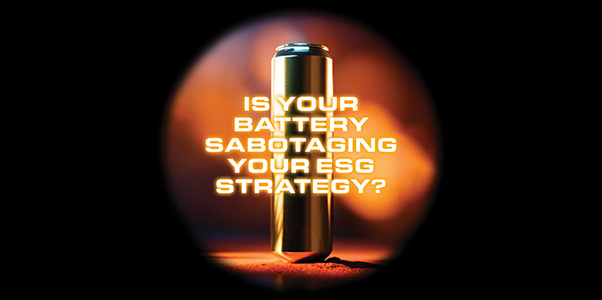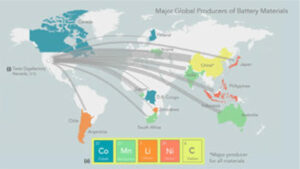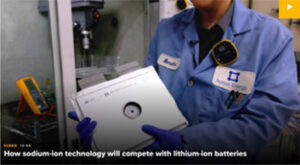
By Brian Kennedy
Mission-critical facilities may not run on batteries, but they depend on them. For industries represented in the 7×24 Exchange International membership – aerospace, healthcare, manufacturing, technology, and more – even a momentary power loss can cost money and impact lives. This is why an uninterruptible power supply (UPS) system, with batteries acting as the bridge between utility power and generator, is so critical to these facilities.
UPS systems can have a significant impact on an organization’s sustainability goals – in some cases, an adverse impact on both sustainability and safety. There is no such thing as a perfect battery. Every chemistry will have pros and cons and some amount of environmental impact. But battery chemistries differ widely in terms of availability and supply chain, ethics surrounding mining and labor, environmental impact, and safety.
So, while performance and safety are extremely important in a battery solution, let’s also take a closer look at how your UPS battery may be hindering your sustainability efforts.
Batteries and Their Supply Chains
Many rechargeable battery chemistries exist and are used in mission-critical applications:
There are also flow batteries: vanadium and iron-oxide. These battery chemistries are less common and tend to come at a higher initial price tag.
When we say “supply,” we mean not just the availability of battery components but also the supply chain for those components. Every battery has core material sourcing, and some must travel a long way before reaching the manufacturer.
Aluminum is abundantly available, and aluminum batteries can use recycled material. This can help cut down on its energy-intensive refining and processing. The domestic supply chain, however, is poor; most aluminum comes from China and India. This means a higher footprint for transportation over long distances, though recycling can help.
Lead-acid batteries remain the most common battery chemistry in many mission-critical applications. China and Australia source raw lead, though the intensive lead-acid battery recycling program means recycled materials often are regionally or locally sourced.

Nickel is relatively abundant but is heavily consumed by the steel industry. In addition, with much of the nickel supply located in Asian countries like Indonesia and the Philippines, the supply chain to the United States is long and carbon intense.
Sodium is available all over the earth, and as such, its supply chain is short and plentiful.
Ethics
Nearly every mineral used in modern technology must be mined. This means both land and labor use. In some cases, the ethics of extracting different battery materials cross ethical lines.
Aluminum mining poses few human rights issues, but the mining process is hard on the earth and produces a significant quantity of greenhouse gases (GHGs). Aluminum smelting produces nearly 300 metric tons of carbon dioxide a year.1
Lead is toxic, which is one reason a sophisticated recycling program has evolved around its use. This reduces the amount of lead that must be newly mined. But mining continues, and those workers—especially in developing countries—often are exposed to dangerous working conditions at low pay and with minimal government oversight.2

Nickel mining has displaced many indigenous Indonesians and has serious ecological fallout for the islands.4 A recent Wall Street Journal article calculated that a nickel mine in a forested part of the islands “caused greenhouse gas emissions equivalent to 56,000 tons of carbon dioxide. That’s roughly equal to driving 12,000 conventional cars for a year, according to calculations by The Wall Street Journal based on U.S. Environmental Protection Agency data.”5 This is an enormous footprint to create the batteries intended for lower-footprint cars. And it can take the local environment many decades to recover from the strip-mining and deforestation process, even with the restoration efforts mining companies must perform.
Sodium-ion batteries require no rare earth or conflict minerals in their chemistry. The manganese oxide and iron oxide in these batteries are sourced from other industrial processes’ waste, requiring no additional mining. Sodium-ion batteries also help companies meet decarbonization goals: Because they recharge so quickly – in a quarter of the time of lithium-ion and 1/32 of the time of lead-acid – they can better respond to back-to-back power outages, lower energy costs related to recharging, and reduce the amount of time generators
must run.
Safety
How safe are the materials in these batteries? How prone are they to fires?
Aluminum-based batteries use a nonflammable electrolyte, making them much safer than traditional choices like lead-acid and lithium-ion batteries. They are, however, not technically rechargeable; they are refuellable.
Lead-acid batteries are bulky, heavy batteries stacked in the middle of sophisticated, modern facilities. These batteries can overheat when overcharged or discharged too rapidly, a necessary function of a UPS battery. Leadacid batteries leak corrosive and extremely toxic sulfuric acid if damaged or cracked. For safe use, many hazard mitigations must be in place.
Lithium-ion batteries come with a high fire risk and are believed to have contributed to many catastrophic meltdowns in mission-critical facilities in the past five years, including one last year in South Korea and more than one in utility Battery Energy Storage Systems (BESS) in the U.S.6 Lithium-ion batteries can be induced to thermal runaway when overcharged, physically damaged, exposed to high temperatures or humidity, or due to manufacturing defects. Lithium-ion battery fires and explosions can cause severe damage to mission-critical facilities and threaten people nearby. Because of these risks, there are tight regulations on the storage and transport of these batteries.
Nickel-based batteries are safe, as they are not capable of thermal runaway. These batteries vary in disposal safety, however. The zinc and metal hydride varieties are safer than cadmium, which is highly toxic both during the mining process and once the material is inside the batteries. All varieties of nickel-based batteries can lose capacity over time due to repeated charging after a partial discharge, known as the “memory effect.”
Depending on the cell chemistry, some sodium-ion batteries such as those made by Natron Energy are inherently safe. They are significantly more power-dense than lithium-ion and lead-acid batteries, and they are 100% nonflammable and nonhazardous. This means they can be shipped fully charged, exposed to direct flame, and even punctured without any safety risk.

Sodium-ion batteries can immediately discharge without risk of overheating, and they can operate in a wide temperature range (-32°F to 113°F) without safety risks. In UL 9450A testing, these batteries could not be induced to thermal runaway.7 The technology’s power capabilities also support peak shaving and other advanced energy management strategies.
Battery Reliability and ESG Goals Can Be Compatible
From common battery technologies like lithium-ion and lead-acid to those on the rise like sodium-ion, mission-critical facilities have many battery options. There is no simple, “one size fits all” battery choice. Every organization must assess their individual needs, applications, challenges, and risk tolerance.
For companies looking for a more sustainable, safe battery solution, traditional options don’t stand up to newer, improved technologies. Looking beyond density to supply-chain availability, ethical impact, and safety can help mission-critical facilities achieve sustainability goals without compromising expectations for 100% uptime.
1 From IEA, aluminum smelting is “a significant source of CO2, emitting nearly 270 Mt of direct CO2 emissions in 2022 (about 3% of the world’s direct industrial CO2 emissions).” https://www.iea.org/energy-system/industry/aluminium
2See this article from Main Group Metal Chemistry, https://www.degruyter.com/document/doi/10.1515/mgmc-2020-0019/html?lang=en
3See this article from NPR, https://www.npr.org/sections/goatsandsoda/2023/02/01/1152893248/red-cobalt-congo-drc-mining-siddharth-kara
4See Earth Island Journal, https://www.earthisland.org/journal/index.php/articles/entry/nickel-mining-puts-indonesian-fishers-on-edge/
5“EV Makers Confront the ‘Nickel Pickle’,” June 4, 2023, https://www.wsj.com/articles/electric-vehicles-batteries-nickel-pickle-indonesia-9152b1f
6 South Korean fire: https://www.datacenterknowledge.com/business/data-center-fire-triggers-lithium-ion-battery-doubts-south-korea and BESS fires: https://
www.silive.com/news/2023/07/as-2-lithium-ion-battery-site-fires-smolder-in-warwick-more-questions-raised-over-staten-island-facilities.html
7Download Natron Energy’s sodium-ion battery testing report here: https://natron.energy/battery-safety/
Brian Kennedy is Director of Business Development and Marketing at Natron Energy. He can be reached at [email protected].